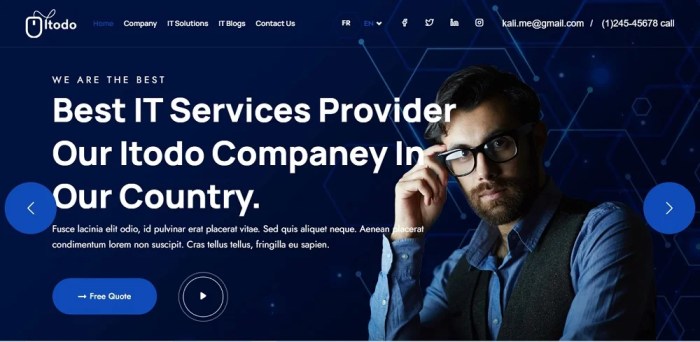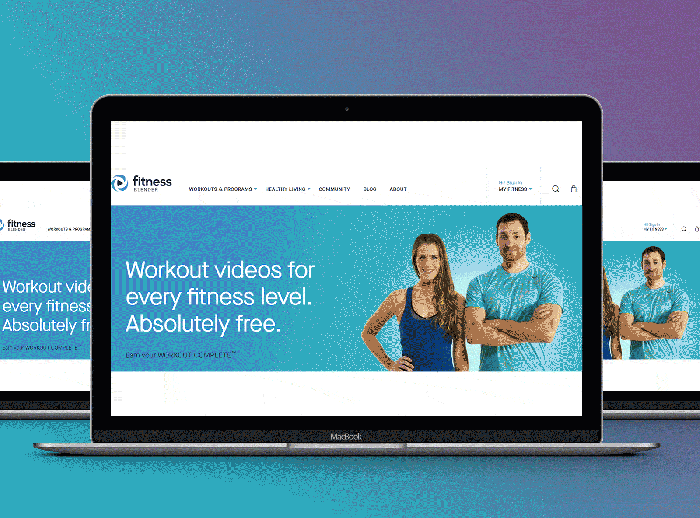Website Design Ideas sets the stage for a journey into the realm of cutting-edge web design trends and innovative concepts. Get ready to dive into a world where creativity knows no bounds and imagination reigns supreme.
From unique color schemes to engaging visual elements, this exploration will inspire and inform you on the latest in website design strategies.
Website Design Ideas

When it comes to creating a standout website, incorporating innovative design trends can make all the difference. From unique color schemes to creative navigation menus, there are plenty of ways to take your website to the next level.
Innovative Website Design Trends
Staying ahead of the curve means embracing the latest design trends. Some innovative ideas to consider include:
- Dark Mode: Dark color schemes are gaining popularity for their sleek and modern look.
- Minimalism: Simple, clean designs with plenty of white space can make a big impact.
- Micro-animations: Subtle animations can add a touch of interactivity without overwhelming the user.
Unique Color Schemes and Typography Combinations
Choosing the right colors and typography can set the tone for your website. Some modern combinations to explore are:
- Contrasting Colors: Bold combinations like black and yellow can grab attention and create visual interest.
- Mixing Fonts: Pairing a sleek sans-serif font with a decorative script font can add personality to your design.
- Gradient Text: Using gradients in typography can create a dynamic and eye-catching effect.
The Importance of Responsive Design
In today’s digital landscape, responsive design is non-negotiable. With the majority of web traffic coming from mobile devices, it’s crucial to ensure your website looks and functions flawlessly on all screen sizes. Some key elements of responsive design include:
- Flexible Grid Layouts: Designing with fluid grids ensures your content adapts to different screen sizes.
- Media Queries: Using CSS media queries allows you to apply different styles based on the device’s screen width.
- Mobile-First Approach: Starting with the mobile design and scaling up for larger screens ensures a seamless user experience across all devices.
Creative Navigation Menus
Navigation menus are the roadmap for users to explore your website. Thinking outside the box with creative menu designs can enhance user engagement and ease of navigation. Some examples to consider are:
- Hamburger Menu: A classic choice for mobile design, the hamburger menu keeps navigation sleek and simple.
- Full-Screen Menus: Taking over the entire screen, full-screen menus provide a visually immersive experience.
- Vertical Navigation: A vertical menu on the side of the page can offer a unique navigation layout.
Engaging Visual Elements

Visual elements play a crucial role in enhancing website design by capturing users’ attention and creating a memorable experience. Images, videos, and animations can help convey information, evoke emotions, and establish the overall tone of a website.
Impact of High-Quality Visuals
High-quality visuals have a significant impact on user engagement as they can make a website more visually appealing and professional. Users are more likely to stay on a website that is visually pleasing, increasing the chances of conversion and repeat visits.
- Choose high-resolution images and videos to ensure clarity and sharpness.
- Optimize images for web use by compressing file sizes without compromising quality.
- Use videos and animations strategically to highlight key content or guide users through the website.
- Consider the color scheme and visual hierarchy to create a cohesive and visually appealing design.
White Space and Visual Appeal
White space, also known as negative space, refers to the empty space between elements on a webpage. It plays a crucial role in enhancing visual appeal by improving readability, focusing attention on key elements, and creating a sense of balance.
- Utilize white space to create breathing room and prevent visual clutter.
- Allow for adequate spacing between text, images, and other elements to improve readability.
- Use white space strategically to draw attention to important content and create a sense of elegance and sophistication.
- Experiment with different layouts and spacing options to find the right balance for your website design.
User Experience (UX) Design: Website Design Ideas
User Experience (UX) design is crucial in website development as it focuses on creating a seamless and enjoyable experience for the user. By implementing good UX design principles, websites can enhance user satisfaction, increase engagement, and ultimately drive conversions.
Principles of Good UX Design
- Clear and Consistent Navigation: Ensure that users can easily find what they are looking for with a clear navigation menu and consistent layout throughout the website.
- Mobile Responsiveness: Optimize the website for mobile devices to provide a user-friendly experience across different screen sizes.
- Fast Loading Speed: Minimize loading times to keep users engaged and prevent them from abandoning the site due to slow performance.
- Accessible Design: Make sure the website is accessible to users of all abilities, including those with disabilities.
- User-Centric Approach: Design with the user in mind, focusing on their needs, preferences, and behaviors to create a personalized experience.
Significance of User-Friendly Interfaces and Intuitive Navigation
User-friendly interfaces and intuitive navigation are essential components of good UX design as they help users easily interact with the website and find the information they need. Clear navigation menus, clickable buttons, and logical flow of content contribute to a positive user experience, leading to increased engagement and conversions.
Websites with Exceptional UX Design
- Apple: Known for its sleek design and intuitive user interface, Apple’s website provides a seamless browsing experience for users.
- Airbnb: Airbnb’s website offers a user-friendly interface that makes it easy for users to search for accommodations and book their stay.
- Google: With a simple and clean design, Google’s website exemplifies the importance of clear navigation and fast loading speed.
Micro-Interactions to Improve User Experience
Micro-interactions are subtle animations or feedback elements that enhance user engagement and create a more interactive experience. Examples include hover effects, loading animations, and confirmation messages that provide instant feedback to users, making the website more engaging and user-friendly.
Branding and Consistency
In website design, branding elements play a crucial role in conveying the identity and values of a company or organization. Consistency in branding helps build trust with users and fosters brand recognition. Let’s dive into the importance of branding and ways to maintain consistency across a website.
Importance of Branding Elements
Branding elements such as logos, colors, typography, and imagery are key components that help establish a visual identity for a brand. These elements create a cohesive look and feel that resonates with users and differentiates the brand from competitors. By incorporating these elements strategically, a website can effectively communicate the brand’s personality, values, and message.
- Logos: A well-designed logo serves as the face of the brand and should be prominently displayed on the website to enhance brand recognition.
- Colors: Consistent use of brand colors helps create a strong visual identity and evoke specific emotions associated with the brand.
- Typography: Choosing the right fonts that align with the brand’s voice and style is essential for maintaining consistency across various web pages.
- Imagery: High-quality images and graphics that reflect the brand’s values and resonate with the target audience can enhance brand perception.
Maintaining Brand Consistency
To ensure brand consistency across a website, designers should adhere to style guides that Artikel specific guidelines for using branding elements. These guidelines help maintain a unified look and feel throughout the site, regardless of the number of pages or sections. Consistency in typography, color palette, imagery, and tone of voice across all touchpoints reinforces brand identity and fosters user trust.
Examples of Effective Brand Communication, Website Design Ideas
Websites like Apple, Nike, and Coca-Cola are prime examples of brands that effectively communicate their identity through design. From their logo placement to color schemes and typography choices, these brands maintain a consistent visual language that resonates with their target audience and reinforces brand recall.
Impact of Consistency on Brand Perception
Consistent use of branding elements such as typography, color palette, and imagery can significantly impact brand perception. When users encounter a cohesive and well-executed brand experience across a website, they are more likely to trust the brand, engage with the content, and develop a strong affinity towards the brand. Brand consistency helps build credibility and loyalty among users, ultimately driving brand success.






